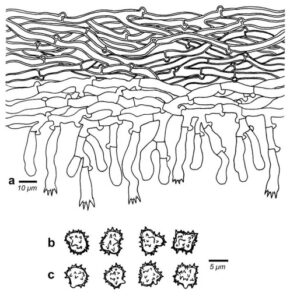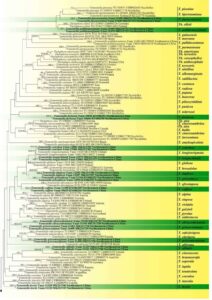Tomentella olivaceobrunnea H.S. Yuan, X. Lu & Y.C. Dai, sp. nov.
Index Fungorum number: IF 555766; MycoBank number: MB 555766; Facesoffungi number: FoF 05637; Figs. 1, 2, 3
Etymology – Refers to the olive brown hymenophoral surface.
Holotype – IFP 019311.
Basidiocarps annual, resupinate, adherent to the substrate, mucedinoid, without odour or taste when fresh, 0.3–0.6 mm thick, continuous. Hymenophoral surface granulose, brownish grey to olive brown (4D2–4E5) and concolorous with subiculum when dry. Sterile margin often indeterminate, farinaceous, concolorous with hymenophore. Rhizomorphs absent. Subicular hyphae monomitic; generative hyphae clamped and rarely simple septate, slightly thick- to thick-walled, occasionally branched, 3–6 μm diam, without encrustation, pale brown in KOH, cyanophilous, inamyloid. Subhymenial hyphae clamped and rarely simple septate, thin-walled, occasionally branched, 4–7 μm diam; hyphal cells short and inflated, hyaline to pale brown in KOH, acyanophilous, inamyloid. Cystidia absent. Basidia 15–40 μm long and 5–8 μm diam at apex, 4–5 μm at base, with a clamp connection at base, clavate, not stalked, sinuous, rarely with transverse septa, hyaline in KOH and in distilled water, 4-sterigmate; sterigmata 2–8 μm long and 1.5–2 μm diam at base. Basidiospores slightly thick-walled, (6–)6.5–7 (–7.5)×(5–)5.5–6(–6.5) μm, L=6.68 μm, W=5.66 μm, Q =1.15–1.23 (n=60/2), subglobose to bi-, tri- or quadra-lobed in frontal and lateral views, echinulate, pale brown in KOH and distilled water, cyanophilous, inamyloid; echinuli usually isolated, sometimes grouped in 2 or more, up to 1 μm long.
Material examined – CHINA, Liaoning Province, Qingyuan County, Experimental Station of Forest Ecology, on fallen angiosperm branch, 3 August 2016, Yuan 11194 (IFP 019311, holotype); on rotten angiosperm wood debris, 31 July 2017, Yuan 12148 (IFP 019312).
GenBank numbers – ITS: MK211728, MK211729; LSU: MK446399, MK446400.
Notes – Tomentella griseocastanea and T. olivaceobrunnea formed a clade in the phylogeny (Fig. 4), and they share the same morphological and anatomical characteristics: mucedinoid and continuous basidiocarps adherent to the substrate, a farinaceous sterile margin, short and inflated subhymenial hyphal cells, clavate basidia and the absence of rhizomorphs and cystidia. But, T. griseocastanea is differentiated by greyish brown basidiocarps and subglobose to bi-, tri- or quadra-lobed basidiospores. T. coerulea is similar to T. olivaceobrunnea by having continuous basidiocarps adherent to the substrate, a granulose hymenophoral surface, a farinaceous sterile margin, the absence of cystidia, and subglobose to bi-, tri- or quadra-lobed basidiospores. However, T. coerulea differs by its greyish brown to dark brown basidiocarps, pale greyish brown and whitish sterile margin and the presence of rhizomorphs (Kõljalg 1996; Daemmrich 2006; Melo et al. 2006).

Figure 1 – A basidiocarp of Tomentella olivaceobrunnea (IFP 019311, holotype)

Figure 2 – SEM of basidiospores of Tomentella olivaceobrunnea (IFP 019311, holotype)

Figure 3 – Microscopic structures of Tomentella olivaceobrunnea (IFP 019311, holotype). a Section through a basidiocarp. b Basidiospores in frontal view. c Basidiospores in lateral view

Figure 4 – Phylogenetic position of Tomentella species inferred from the ITS sequences. Bootstrap support values for ML≥50% and Bayesian posterior probabilities≥0.95 are given near nodes respectively. The tree is rooted with Odontia fibrosa (TU115714). The new species are in bold
